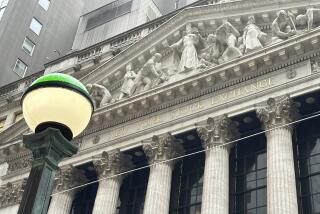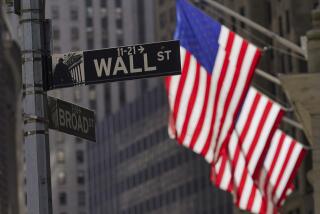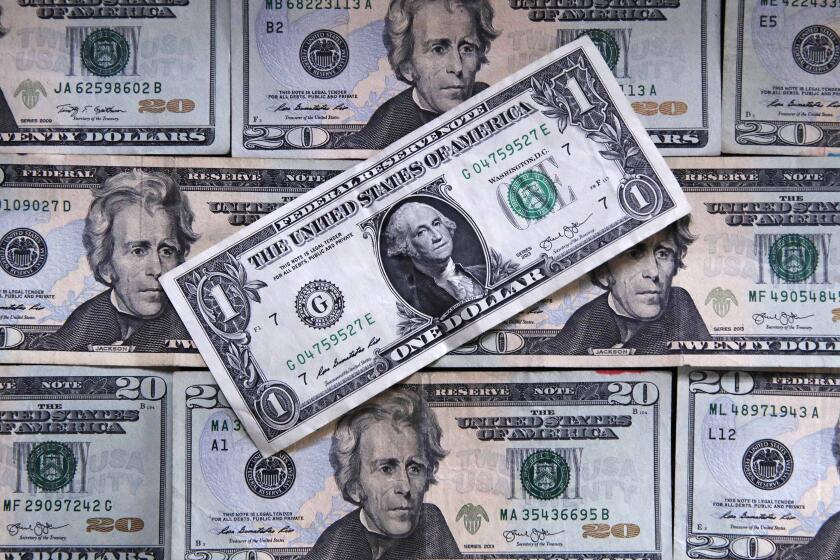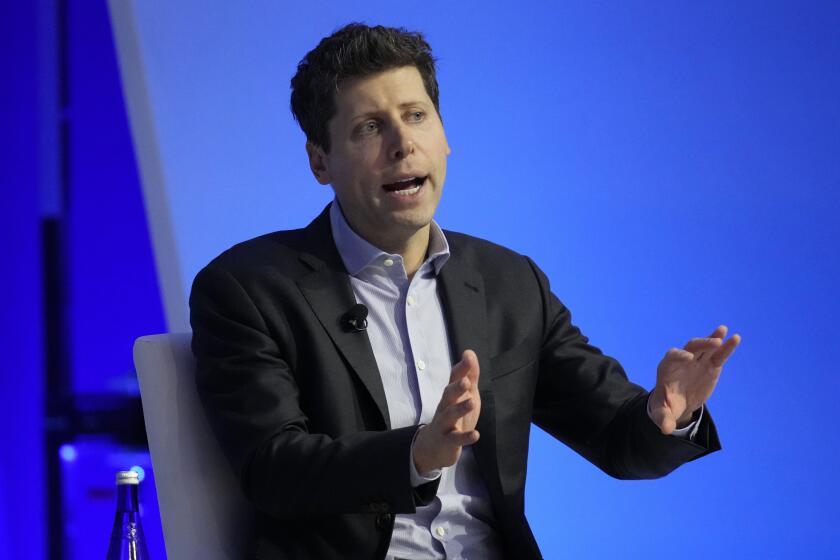Don’t Count Bonds Out Yet
- Share via
Prospects for an economic revival and a pickup in corporate sales and earnings could make 2002 the first year in the new century in which bonds fail to outperform stocks, Wall Street analysts say.
However, the risks of continued economic weakness and of a geopolitical shock like the terrorist attacks of Sept. 11 remain high enough that demand for bonds probably will stay strong, and another year of decent bond performance is hardly farfetched, such experts say.
U.S. Treasury bonds, government-agency issues and high-quality corporate and municipal bonds have been the places to be for the last two years, as the stock market floundered and the U.S. economy finally ran out of steam after one of the longest post-World War II expansions.
Falling market interest rates in 2000 and 2001 boosted the value of older, higher-yielding bonds, providing many bondholders with a paper capital gain on top of their interest earnings in both years.
The average total return for government bond mutual funds of all maturities was 6.7% last year, which followed a 10.4% return in 2000, according to Morningstar Inc. Total return counts interest yield plus any gain or loss in a fund’s share value.
By contrast, the average domestic stock mutual fund tumbled 10.9% in 2001 after losing 1.9% in 2000, Morningstar data show.
Lately, however, investors have soured on the Treasury market, anticipating an end to the Federal Reserve’s intense credit-easing campaign, during which the central bank chopped its key short-term interest rate target 11 straight times, to 1.75% from 6.5%, in less than a year.
If the early signals of a comeback in the domestic economy are confirmed, investors might continue to push longer-term Treasury yields higher, analysts warn. Just since the end of November, the yield on the 10-year T-note has jumped from 4.75% to 5.13% now.
For fixed-income investors, the main beneficiary of an economic recovery could be the corporate “junk” bond sector, which, like the stock market, has underperformed investment-grade bonds for two years.
Last year, junk bond mutual funds delivered an average total return of just 1.5%, according to Morningstar. That reflected the plunge in the bonds’ prices, which offset most of the high interest income the securities paid.
But “what’s bad news for Treasuries may be better news for low-quality bonds” in 2002, said investment strategist William E. Rhodes of Rhodes Analytics in Boston.
Here’s a look at last year’s performance of key bond market sectors and the 2002 outlook:
*
Treasuries
Not that anyone could have wished for such a reminder, but Sept. 11 demonstrated once again that Wall Street is vulnerable to far more than just economic cycles.
The terrorist attacks sparked a stampede for the safety of Treasury securities. Even triple-A-rated corporate bonds were ditched in the rush to safety.
In the aftermath of the attacks, the yield on the benchmark 10-year T-note fell to 4.18%, a low not seen since October 1998, when Russia’s bond default triggered a financial panic.
Treasury yields have been climbing fairly steadily ever since the attacks, reflecting signs of economic strength and some investors’ shift of money from bonds to stocks.
The consensus of 24 economists surveyed by the Bond Market Assn. is for an economic recovery that begins in the second quarter and produces full-year gross domestic product growth of 2.5%, adjusted for mild, 2% inflation.
Most of the surveyed economists think the Fed will resume raising short-term interest rates in the third quarter and that the Fed’s key rate will rise to 2.5% by year-end.
Such a scenario would make this a lackluster year for the Treasury market, analysts say. At best, owners of Treasury bond mutual funds might earn a yield in the 4%-to-5.5% range and see their share values hold steady. But if the economy’s recovery is more robust than expected and yields on new Treasury issues rocket, government bond fund share values could decline significantly.
Some analysts, however, believe the greater risk is that the economy sputters again. Economists at the Jerome Levy Forecasting Center in Mount Kisco, N.Y., believe that the financial bubble of the 1990s has left the nation with a huge private debt burden that probably will be wrung out by years of slow growth, with weak consumer spending and business investment.
Srinivas Thiruvadanthai, research director at the Levy Center, expects inflation to hover around zero and a fitful economic recovery to begin in the second half. Under that scenario, the chance of the Fed raising rates this year is almost nil, he contends.
In his view, Treasuries once again will rule in terms of bond-market performance. He expects the yield on the 30-year T-bond to fall to 4% this year from 5.54% today. New terrorism or other political problems would only heighten the appeal of super-safe Treasuries, he said.
*
Corporates
If long-term interest rates continue to creep up in 2002 and the economy strengthens, chances are that many companies will pull back on their issuance of new debt after a blockbuster year for issuance in 2001, experts said.
That’s likely to be true particularly if a rising stock market enables companies to raise capital more cheaply that way.
The improving economy should cause a narrowing of “spreads” between the yields on Treasuries and corporate bonds of similar maturity, according to Michael Maurer, bond strategist at brokerage A.G. Edwards in St. Louis.
The terrorist attacks and the quick descent of the U.S. economy in 2001 kept corporate yields high relative to Treasury yields. So even if Treasury rates stay flat this year, corporate yields have room to decline, Maurer said.
When default risks outweigh fears of inflation, as in an economic downturn, higher-quality bonds tend to be in greatest demand. But as economic conditions improve and companies start generating stronger cash flow, investors get bolder and start shopping for higher yields, bidding up the values of corporate bonds.
That process got going in the fourth quarter of 2001, as junk bond mutual fund total returns averaged 5.5%, while total returns went negative or barely positive for government and most investment-grade corporate bond funds.
Some analysts believe that the rush back into the junk bond market may have been premature. Martin Mauro and William Scapell, fixed-income analysts at Merrill Lynch & Co., for example, said they “suggest a fairly low allocation to the [junk] sector for now, but we expect to increase that allocation once the near-term prospects for the economy start to look brighter.”
Among corporate bond sectors, they favor “conservative industries such as aerospace and defense, insurance and selected utilities,” while recommending caution toward bonds of airlines, banks and brokerages, autos, capital goods and paper and forest products firms.
Economist David Blitzer at Standard & Poor’s Corp. thinks 2002 could be a good year for junk bonds after a dismal three-year period. But he notes that investors--and junk bond fund managers--need to be highly discriminating in the type of junk they own. “If you’re going to do all that research, you might as well buy the stocks and have more fun,” he said.
*
Tax-Free Municipals
New York Mayor Michael Bloomberg took office last week, calling for 20% job reductions in some city departments as a means of coping with Gotham’s fiscal woes.
California officials, meanwhile, are debating ways to reduce a projected $12-billion budget deficit.
Although red ink has begun flowing again in many state and municipal budgets after years of surplus, analysts maintain that most local government entities remain in pretty sound shape financially and are able to take on some deficit spending while waiting for the economy to turn around.
That could leave investors quite willing to buy tax-free muni bonds at or near current yields, analysts say.
In California, 2001 was a record year for municipal bond issuance, with $31 billion of bonds floated, or more than 11% of the nationwide total, said Zane Mann, editor of the California Municipal Bond Advisor newsletter in Palm Springs.
More than one-third of the total were “refunding” bonds, meaning their proceeds were used to pay off older, higher-interest bonds, as issuers took advantage of lower rates to reduce their borrowing costs.
Volatility was severe in most parts of the bond market last year, but munis were an oasis of relative calm. The average yield of longer-term California munis ranged from 4.91% to 5.36% during the year--the smallest swing in the 18 years that Mann has been recording such numbers, he said. “That’s a tribute to the orderliness of the tax-exempt market,” he said.
Even so, most muni bond mutual fund categories recorded negative total returns in the fourth quarter, as price declines outweighed interest earnings.
Mann, like other analysts, thinks California muni issuance probably will decline from last year’s record level but remain strong overall. Demand, too, should continue strong because munis’ tax exemption is one of the best ways for people to deflect some of the state’s high income taxes, he said.
A muni bond yielding 4.6% is the equivalent of a taxable bond yielding 7% for someone in the 35% federal marginal tax bracket. With yields on money-market funds and other short-term securities at record lows of 2% or less, more investors are likely to be hunting for better returns in 2002, which could help muni performance.
Munis boast a safe record: Historically, muni bond defaults are rarities, unlike corporate bond defaults. Still, in a weaker economy investors shopping for individual muni issues need to be more careful, Mann said.
The main areas of caution should be in airport muni bonds, because of the risks that grew out of the terrorist attacks, and in the hospital bond sector, as health-care costs keep rising while government reimbursement keeps falling, he said.
*
TOP-RATED BOND FUNDS Bond funds, ranked according to a system developed by The Times and fund tracker Morningstar Inc., are listed in more than a dozen categories beginning on U10.
*
Treasury Yields
(tabular data not included)
More to Read
Inside the business of entertainment
The Wide Shot brings you news, analysis and insights on everything from streaming wars to production — and what it all means for the future.
You may occasionally receive promotional content from the Los Angeles Times.










